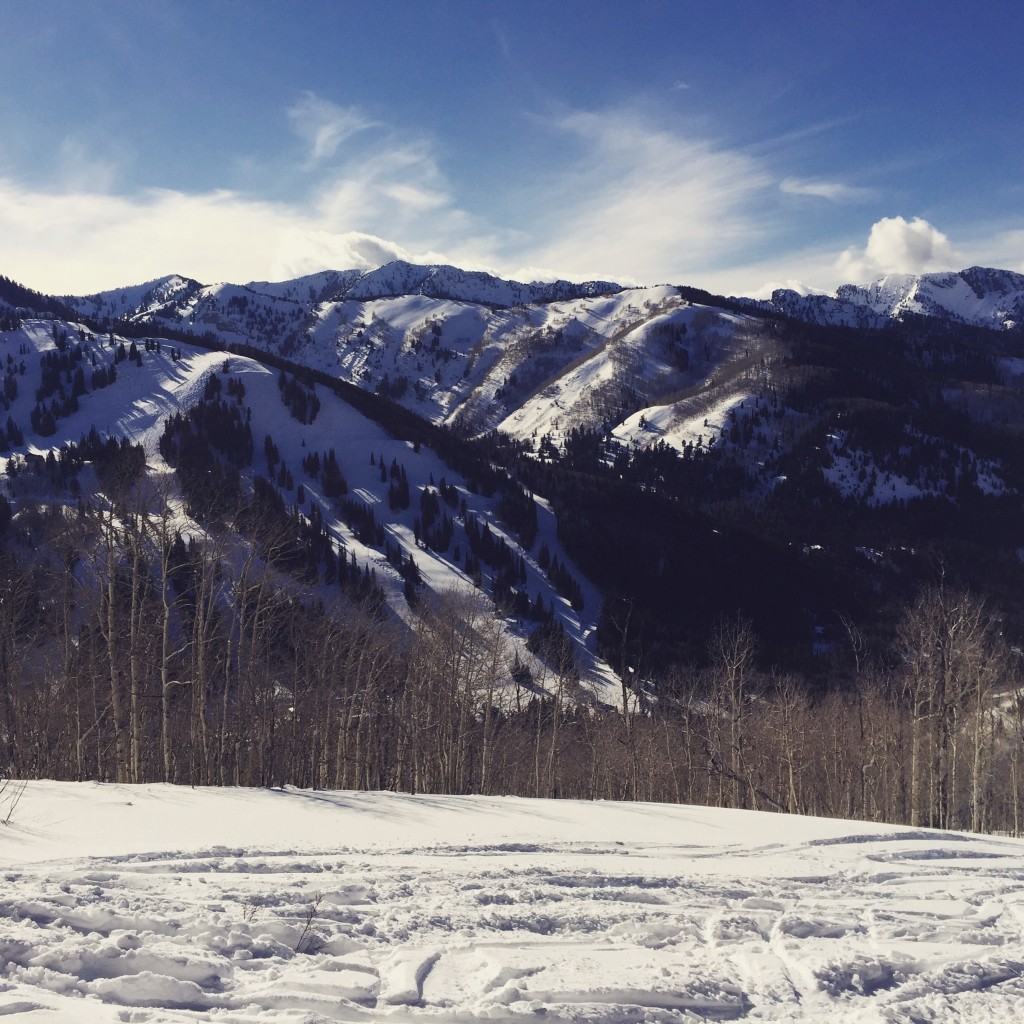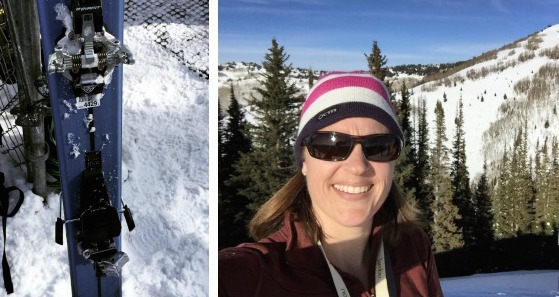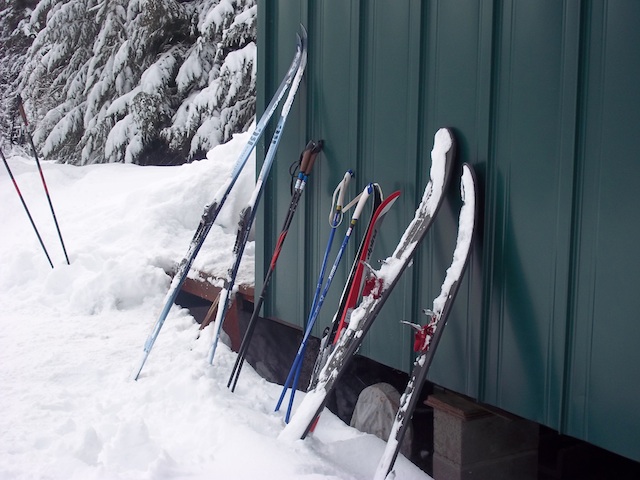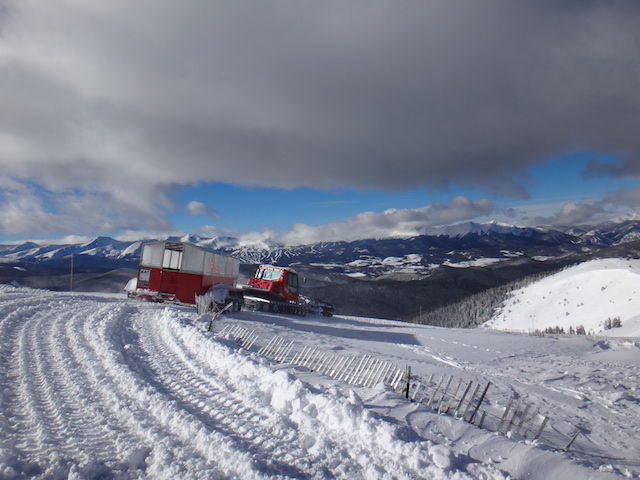It’s never been a better time to get into the backcountry and leave the crowds behind! Here’s how to get into the sport during the COVID season!
An avid downhill skier and snowshoer, I’ve been noting the small but growing trend toward backcountry skiing for some time now. This sport, which combines a love of nordic exploration and downhill excitement, attracts men and women (and yes, some kids) who want to carve their own line down mountain terrain and explore the wilderness at the same time.

I got my first pair of backcountry skis in 2012, which were basically fat nordic skis with a three-pin binding. I found I could navigate single-track nordic trails with steep inclines much better than my nordic skier counterparts, and I was hooked. Today, all-terrain (or AT) ski gear is much more involved, but AT skiing is still a fairly diverse term. Just like the sport itself, it can mean something different to every enthusiast, from short hikes up to freshies from lift-accessed runs to full-day expeditions with beacons and probes.
In January, I was lucky enough to experience the sport in more depth, this time trying out top-of-the-line AT skis, boots, and bindings on a half-day, strenuous backcountry ski day in Utah’s Cottonwood Canyon near Solitude Mountain Resort.
I headed out with Utah Mountain Adventures after getting outfitted with Voile skis with Dynafit bindings and Scarpa AT boots. I carried a backpack with plenty of water, plus a shovel and avalanche probe. I strapped an avalanche beacon, provided by Utah Mountain Adventures, to my body.

The only way to get fresh powder runs was to climb uphill, so my first lesson was in putting on skins. Turns out, this is easy. The hard part is to climb upslope. We climbed for over two hours, stopping for a few breaks, skinning up a mountainside in the Wasatch Mountains. I’d like to say I enjoyed the whole experience, but in truth, by hour two, I was sweating enough to shed a layer and starting to feel hot spots (which turned into blisters) where my socks rubbed in my boots. I was told to loosen my AT boots for the uphill climb (there’s a walk mode and ski mode), and while I’m sure this is sound advice, it didn’t help on the blister front.
The whole uphill experience reminded me of hiking: there were periods of enjoyment while I took in breathtaking views and reveled in being in the wilderness in winter, but also periods during which I had to set tiny goals–get to the next tree, get to the next open slope–in order to carry on. In other words, it’s crucial to love the outdoors and the uphill ‘hiking’ process, or the joys of backcountry skiing may be lost on you.
Climbing in AT skis is not very difficult–it’s much like cross-country skiing–but there are moments when kick turns may be necessary to zig-zag along steep grades. Yes, there’s a learning curve to this, but here’s what I was told (and it helped): use as much of the flat plane of your ski base as possible. Staying on your edges, where you don’t have skins, won’t help you keep traction.

Once we’d summited a peak in Cottonwood Canyon, the fun began. We took off our skins, stowed them in our packs, and switched our boots and bindings to downhill mode. (Dynafit bindings are unique in that they transition from climbing mode, with the heel untethered, to downhill mode, with the heel locked down just like alpine skiing, with one twist of the back binding. They also feature ‘risers’ that can be raised while in climbing mode, which assist on steep ascents, much like going a gear lower on a bike. Yes, they’re nifty.)
We picked our line for the descent, and carved down the beautiful, light powder. Thanks to the efforts of our uphill hike, the terrain wasn’t skied out like it quickly becomes on lift-accessed terrain. I happily followed the lead of our guide, who knew the area and how to traverse through the glades and open slopes and still find our starting point back at base. Without him, I would have needed a GPS in unfamiliar territory.
Raised in the deep powder of Tahoe, skiing off-piste before I knew what that meant, I loved every second of the descent. Yes, it was challenging, but also very satisfying, knowing I’d earned my turns. I never needed my beacon, but was glad for the security it offered. Back at the base of the mountain, I switched my skis back to climb mode, and ‘cross-country skied’ my way back to the car on flat terrain. The sun was setting by the time we returned, and trust me, I’d earned my pizza and beer.
What you’ll need to get started in AT skiing:
- AT or telemark skis (these are the skis I tried)
- AT or telemark boots (the most comfortable seem to be Dynafit)
- any ski poles
- backpack
- shovel, probe, and beacon
- breathable outerwear
- plenty of layers (wool is best)
Tips for beginners (like me):
I recommend going with a guide, like I did, your first time out (or any time out in an unfamiliar area). Most guide services can also rent AT skis and boots, which are expensive to buy yourself at first. More importantly, guides know where to go and are trained in avalanche safety (check to make sure!).

Any time out in the backcountry, everyone in your party should carry a beacon and shovel, at very least. I fell once during my trip, and lost one ski. It was deeply buried almost instantly, and had it been me, I would have been glad for my beacon, guiding others to me. Luckily, I found the ski without needing my shovel. If you go out without a guide, you should have completed an avalanche safety course. They are offered almost everywhere now, from gear stores to ski resorts.
If you haven’t explored winter terrain at all yet, start by snowshoeing or cross-country skiing. Hit trails you’re familiar with in the summer months; they’ll have a different feel in winter! Alternatively, try backcountry skiing from lift-accessed terrain. At any ski resort, look at a terrain map to see where off-piste (or non-groomed) terrain is located. Make sure it’s open the morning of your ski, and then climb only from the top of a lift (shortening your ‘hike’). Yes, others will have the same idea, so make this one of your first few runs of the day. Afterward, relax with some cruisers. Some resorts, such as Keystone Mountain in Colorado, even offer cat rides to off-piste terrain, allowing skiers to find fresh powder without AT gear.

Can kids AT ski? Sure, though it’s currently hard to find skis and boots to fit kids under age 12 or so. There’s a reason for this: AT skiing is a lot of work. My recommendation (that I’m following with my own kids): introduce the idea of backcountry exploration when kids are small, with snowshoe treks. Then, graduate to AT skiing when kids are teens. Make sure they’re expert skiers on groomed terrain, too.
Can snowboarders AT ‘ski’? Yes, Voile and other makers are now creating split snowboards, which split into two short ‘skis’ for the uphill climb, then come together to create a board for the downhill. It’s the coolest transformer yet!
I’ve heard the argument that AT skiing is popular because skiers can avoid the high cost of lift tickets. While this is true, and while I do think most lift ticket prices have gotten out-of-hand, I don’t think true AT ski lovers climb miles of terrain for this savings. It’s simply too much work to do it for any reason but a love of the outdoors and the sense of freedom. It’s a way to challenge oneself outside of the ski resorts, and well worth the effort of learning a new discipline within alpine skiing.
I toured the Wasatch with Utah Mountain Adventures at no cost, for the purpose of testing AT ski gear.





